L’Obsession (original) (raw)
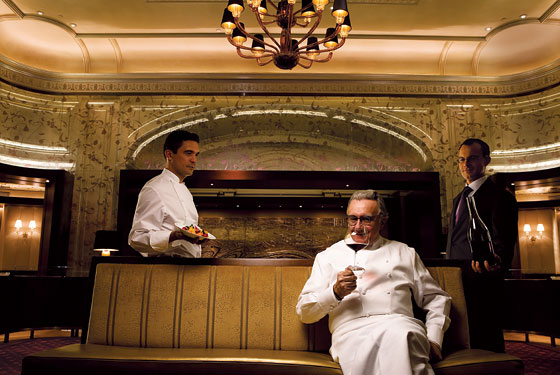
Ducasse at Adour, with executive chef Tony Esnault, left, and sommelier Thomas Combescot-Lepère, right. Food styling by Victoria Granof.Photo: Hans Gissinger
Under a bald lightbulb, the table was set. Weighty silver on virgin linen, swan-necked wine decanters, crystal glasses, and glistening china—a pinpoint of elegance amid the chaos of Alain Ducasse’s unfinished restaurant. In the dining room of Adour, which will open in the St. Regis the last week of January, plywood covered the floor at precarious angles and thick black wires cut through the air. Only the kitchen was functional, and Ducasse’s executive chef, Tony Esnault, was preparing ten courses from the menu he and Ducasse had been trying out for months.
“C’est beau. C’est savoureux,” Ducasse commented, peering through horn-rims at the underside of the Comté-coated and lemon-spritzed bagel—a nod to New York—that accompanied a cauliflower velouté. The dish had been preceded by a geometric arrangement of marinated sea scallops, and it would be followed by a poached egg on brioche, seared duck foie gras, Pacific halibut, Maine lobster, Berkshire pork, Millbrook venison, Vacherin with meringue, and pear clafouti. Two glasses of wine, sometimes three, accompanied each course. And Ducasse, slim for a man of his age and occupation, still had dinner reservations later that night. At two different restaurants.
“It’s a serious business, pleasure,” he said pleasantly.
A self-proclaimed “merchant of happiness,” Ducasse peddles his product in eight countries, on three continents. His empire includes 24 restaurants, four inns, four bakeries, two cooking schools, a hotel consortium, and a publishing house. In France, where he is famous enough to get fawned over in the street, he was the youngest chef ever (at 33) to achieve that pinnacle of excellence, three Michelin stars, the first chef in 60 years to win six Michelin stars at once (at age 42), and is currently (at 51) one of the most star-studded chefs on the planet, with his own little galaxy of fifteen. He sleeps four hours a night. He travels incessantly. He has been called “Robo-chef.” He is possessed of, or by, an insatiable appetite for achievement. It’s difficult to tell if he’s boulimique du travail, a workaholic, chronically unsatisfied, as the French press has accused, or simply the Frenchified version of the American Dream, a poster child for Sarkozy’s plan to show the Gauls that there’s nothing gauche about working for a living—or about being a whopping, international, franchised success.
A whopping success everywhere except New York. For Ducasse, New York is unconquered terrain, a city seemingly immune to his concoctions. In 2000, with much fanfare, Ducasse announced that he would make his American debut with Alain Ducasse at the Essex House. Foodies gushed. Gourmands swooned. Finally, New York was going to be graced with Ducasse’s luminous presence. The restaurant received the requisite four stars from the Times, but succumbed last year to the cold shoulder of a city scandalized by the prices and the pretension. (A $225 prix fixe? A choice of ten pens with which to sign the frightful bill? Lollipops?) A second, more populist venture, Mix, which opened in 2003, had an even shorter shelf life.
“It’s like a play, a bit of theater, a casting,” he says obliquely. “The performance is the food. With a play, there can be magic some nights and not on others. An actor can have a good connection with his public some nights, but not connect on others. It doesn’t always work.” It’s the closest he comes to acknowledging what went wrong before.
Since the day his restaurant at Essex House closed its doors, he has been plotting his return, searching for the exact combination of elements to mix together in the old Lespinasse space in the St. Regis so that New York finally, belatedly, applauds. “I have Paris, Monaco, Tokyo,” he says, “but New York is a rite of passage to continue to conquer the world. New York gives you global legitimacy. One can live without New York,” he assures. “But it’s better not to.”
Americans think of French food in much the same way they tend to think of French people. That is to say, it/they would be the sexiest, the most sophisticated, the most desirable cuisine/culture in the world if only it/they weren’t so damn … French. So demanding: of time, of patience, of savoir-faire. So fussy. So superior. At the Essex House, Ducasse played into the stereotype, bestowing on New Yorkers an experience so over-the-top “French” that it wouldn’t have been tolerated even in France. He gave us gaudy, old-world gloom, finicky emulsions, high-concept crackers, and one server per client, as if everyone were used to commanding his own valet. “The opening was a public-relations disaster because of a foolish attempt to teach New Yorkers what luxury was all about,” says Michael Whiteman, the restaurant consultant who co-created Windows on the World and the Rainbow Room. “The food was superb, although fairly old-fashioned, but that initial nonsense of multiple knives shoved at customers so that they might properly carve their pigeons almost got him laughed out of town.”
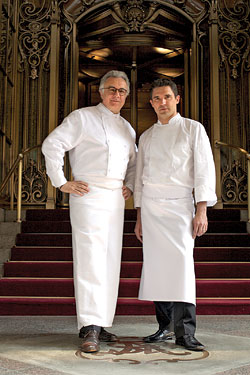
Ducasse and Esnault.Photo: Courtesy of Mikael Vojinovic.
Three years after the opening at Essex House, Ducasse introduced Mix, as if to prove that he was a fun guy after all. Quashing the idea of stuffy French fare, Mix sought to marry down-home American dishes (PB&J) with quotidian European cooking (bouillabaisse) in a way that elevated each beyond its humble origins. The idea worked in campy Las Vegas, where Mix is still going strong (with a Michelin star to boot), but New Yorkers found it schizophrenic, confusing, another case in which Ducasse grossly miscalculated what this city would want.
It could be that Ducasse, like a man trying to woo a distant lover, was simply trying too hard. “There are difficult clients,” he admits. “The Parisians and the New Yorkers are terrible. The Parisians are spoiled by history, and they are very demanding and arrogant. But New Yorkers have everything because they’re in New York. They eat out five times a week. There’s so much on offer, so much diversity, so much that’s good. The competition is very intense.”
Being French, he cracked the code to the demanding Parisians quickly, building on their “good roots,” as he says, simplifying some classic dishes, sculpting others, providing simpering service to pad their egos (no sneering garçons ashing into your haricots verts chez Ducasse). He now has twelve restaurants in the City of Lights—more than in any other city—the three-star crown jewel being his eponymous restaurant at the Plaza Athénée. (“I have never seen such a meal,” my expat sister gasped, tears literally welling in her eyes, during our twelve-course extravaganza there. “I didn’t even know it existed.”) These are restaurants that speak to the Parisian soul: the belief in the value of craftsmanship, the sense that pleasure is a basic human right.
“Everyone in New York is so rushed, you have to give them easy pleasure,” says Ducasse. “One must have a clear message, no confusion.”
New Yorkers are different. They don’t want their pleasure to feel even remotely like work, don’t want their dinner to need much explaining, don’t want to be given a utensil they don’t know how to use, don’t want to be made to feel like uncultured American cretins. Ducasse should have understood this. His favorite, most memorable meal is still the first three-star one he paid for himself, saving up a cooking trainee’s meager funds to dine for one night like the Sun King. “I had a lobster salad and a gibier, and it was as if I were eating for the first time in my life,” he remembers.
But Ducasse’s missteps were not solely the result of cultural differences. There was also the unlucky fact that he came to New York when French cooking was in decline here. Not long after he opened Essex House, the Towers fell, the recession started, and we went to war. Suddenly, it seemed frivolous, even unseemly, to sit down to a five-bite meal that it took ten people three days to construct. Throw a brioche down Broadway today and you’ll hit a simulacrum of a certain type of French café that never actually existed in France, but the real old-French bastions, the pristine purveyors of haute cuisine, couldn’t withstand the cultural shift; Lespinasse, La Côte Basque, Lutèce, all bid the city adieu.
If anyone has managed to tap into New York’s Zeitgeist in recent years, it’s Mario Batali, the Italian chef who’s so “American” he is, in fact, American. His dishes are bold but his restaurants undemanding. You can go in jeans (the reservation line soothingly tells you that coat and tie are not required), throw back a beer (made especially for him by Brooklyn Brewery), get a bit rowdy. His brash, florid, larger-than-life cuisine personifies his temperament—and explains why New Yorkers in particular love him. When he and Ducasse bumped into each other at Chelsea Market on one of Ducasse’s recent trips to New York—Batali coming from the kitchens of the Food Network, Ducasse visiting a mural that was being painted for Adour—it was like watching continents collide.
“Chef!” Batali beamed, engulfing Ducasse in a bear hug.
“Chef,” Ducasse greeted him politely, ducking out from under Batali’s arms, smoothing his suit.
“You good? You look good. He’s fucking gold,” Batali gushed as a bevy of assistants fluttered about. He gave Ducasse a slap on the back. “How is Adour?”
Ducasse explained in halting English that he had come to see the artwork for the restaurant, which was in its final stages. “A masterpiece,” he deemed it. “And you?”
Batali motioned off into the distance. “These butchers over here? They’re fucking drowning. So we’re gonna do a steakhouse for hipsters. We’re gonna have cheap steaks. Twenty-five-dollar steaks.” He held up two fat fingers, pinching them close. “Fucking little steaks.” He burst into a guffaw. Ducasse smiled demurely. Both sets of handlers checked their watches, rifled through planners. “All right, baby,” Batali said. “Arrivederci.”
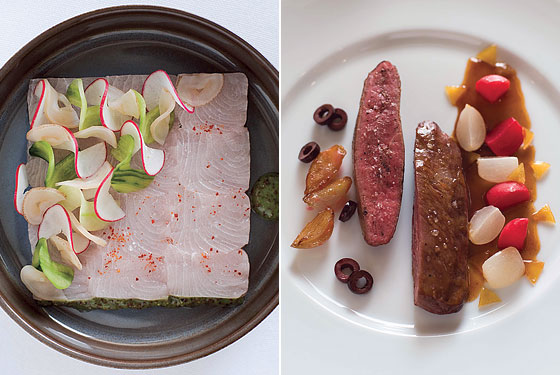
Dishes from the Adour menu.Photo: Michael Piazza.
“Ciao,” Ducasse replied.
Batali watched Ducasse meander away. “Man, he’s fucking awesome,” he said. “It’s not even embarrassing to say that.”
Ducasse has been spending a lot of time in New York recently, trying out our food before attempting again to offer us his. He’s eaten at McDonald’s, had barbecue, bought hot dogs off the street. One day he asked me where to find the city’s best burger. I took him to Corner Bistro, where, between bites of greasy deliciousness, he talked about Giuliani’s White House odds. At the end of the meal, he dipped his fries in the bacon juice and said, “Now, that was some good fat.”
Part of any successful culinary venture entails getting into the heads of the people you’re trying to please, translating their cultural desires, which Ducasse has been able to do most everywhere else. His concept of terroir, the physical conditions—sun, soil, and climate—of a place that give it a particular culinary heritage, extends to the conditioning of taste buds. “There’s a mental terroir in New York, an intellectual and cultural perimeter in the way people feed themselves. When you open a restaurant, it’s not the same in London, in Paris, in Tokyo or New York. You always have to understand the men and women who live in that town. Every place has its own mental terroir.”
And Ducasse thinks he has finally figured ours out. “One must have a clear message, no confusion,” he says. “Clarity, that’s our philosophy. Everyone in New York is so rushed, so stressed, you have to give them easy pleasure. It won’t be necessary to have a qualification to enjoy it, one must simply be open to it. That’s what we’re proposing to New Yorkers.”
With this newfound insight, Ducasse is launching a two-pronged attack on the city that wouldn’t have him: Adour, but also Benoit New York, the latest franchise of his classic Paris bistro, slated to open this spring. Benoit will give Ducasse a foothold in New York’s casual-bistro market, but of course his focus is on the more serious offering at the St. Regis.
Ducasse calls Adour a return to his roots, a paring down of his cuisine to the haute version of fundamentals—fine ingredients made, through painstaking preparation, to taste even more like themselves. The restaurant is named after a river close to his hometown of Castel-Sarrazin in the Landes province of southwestern France. Ducasse grew up on a farm that his family had run for generations, raising chickens, ducks, pigs, and rabbits, growing wheat and vegetables. In his bedroom over the kitchen, he could smell the varied aromas rising from his grandmother’s traditional cooking. By age 12, he says, he knew he wanted to be a chef, but his grandmother—annoyed at his questions and his commentary (he once famously complained that her beans were overcooked)—refused to teach him, sending him instead to the garden to gather vegetables so that he wouldn’t be underfoot. “I now have in my head the original memory of the taste of a tomato, a cucumber, an onion, lettuce,” he explains. “My grandmother would wash them, and exactly ten minutes after they’d been growing, we would eat.”
This belief in essential flavors grew as Ducasse made his way through a parade of impressive kitchens: Michel Guérard’s in Eugénie-les-Bains, Roger Vergé’s near Cannes, and especially Alain Chapel’s outside Lyon. In Chapel, Ducasse found an intellectual mentor. While at one point the sign of a good chef was his ability to turn something practically inedible into something savory, Chapel took the then-revolutionary position that a dish was only as good as the ingredients that went into it. “Feeding yourself from nature,” says Ducasse, “that’s true luxury, absolute and elemental. It cannot be bought. It must be cultivated.”
To understand how all of this translates to Adour, consider the turnip. The great thing about the turnip is its profound turnipness, the fact that it tastes like nothing but a turnip, that nothing but a turnip tastes like it. If you were to cook one at home, you’d probably boil it in water, which you’d later toss down the drain—along with much of the original turnip flavor. Knowing better, a restaurant would cook the vegetable in chicken broth or, if it wanted to be fancy, veal stock. Some turnip flavor would be lost, but another flavor would be gained. But how to get a turnip to taste more like a turnip? If you’re Ducasse, you create a turnip consommé or a reduction sauce and then cook your vegetable in that, so when the turnip is served in “Multicolor Vegetable Composition (With a Natural Jus Reduction),” for instance, the essence of the flavor is not only retained, it’s exalted.
Not that diners need to understand the philosophy behind their perfectly turnipy turnip. Adour will not be a restaurant of lengthy descriptions and explanations. The Ducasse team also assures that pricing will be “different” from that at Essex House (although a price list has yet to be released). And having noticed that wine is the one French product Americans take to with unconditional vigor, Ducasse is, for the first time, giving wine equal billing with food. Gérard Margeon, the group’s global sommelier, has created meticulous pairings, usually one red and one white selection for each dish. There will be private wine lockers, and selections of wine difficult to find even in their countries of origin. “We’re going to propose something different,” Ducasse told me. “A concentration of our knowledge, harmony between food and wine, complementary pleasure.”
When Ducasse talks about a homecoming, he’s talking about a return to the nobleness of simplicity, but it will still be served up in fancy digs, with a few truffle shavings on top. He considers Le Louis XV in Monaco, the restaurant where he first achieved three Michelin stars, to be the embodiment of his ideology, offering Mediterranean fare in a setting so opulent as to almost feel incongruous. Think Marie Antoinette playing shepherdess at the Petit Hameau—he makes ice cream using milk from the prince of Monaco’s cows—and you get the idea.
In his approach to the menu at Adour, he’s turning to preparations he knew as a child. And he’s thinking about ingredients the way Coco Chanel thought about accessories—always take one off before leaving the house—asking executive chef Esnault to prepare the same dish multiple ways, leaving out an ingredient each time to see if the taste is purified. There will be lobster (but served in a gratin), hearty sweetbreads, a roasted lamb loin, and “peasant vegetables,” all served à la carte. There will be a bar menu. This approach may come as a surprise to the diners who suffered through the excesses of Essex House or the confusion of Mix, but it is classic Ducasse. He’s putting his most essential philosophy on our plates, and if that doesn’t win over the palates of New York, he doesn’t know what will.
On a cool October morning, as the sun rose, pale and milky, over the sleeping 17th Arrondissement of Paris, Saturday supplies were arriving en masse to the bustling kitchen of Rech, Ducasse’s Art Deco seafood establishment. Laundered linens wrapped in plastic towered over the bar like little obelisks. The clanging of dishes, the sound of running water, and the briny smell of fresh fish spilled from the kitchen out to the wood-paneled dining room, as the staff paraded through with various tasks and an air of expectancy. The next day, 70 chefs from all over France would be dining here, invited on behalf of the association of Châteaux & Hôtels de France, a collective of which Ducasse is the president.
Ducasse arrived around nine, a smattering of stubble powdering his chin. He asked for a coffee—delivered hastily and on an antique platter—downed it in one gulp, and then jogged back out to his car, where the waitstaff helped him unload a half-dozen large prints framed in dark wood.
“These are from the Essex House,” he mentioned nonchalantly, hoisting a picture of a street lamp rising from the flooded quays of the Seine up a narrow flight of stairs. “The problem is, I don’t know how I’ll hang them,” said Delphine Heraud, Ducasse’s director of operations in Paris. She bit her lip and surveyed the paneled walls. “Hmmm, maybe with fishing line?” The corner of a frame careened toward the ceiling, and she let out a little shriek. “Arnaud! Le plafond!”
Meanwhile, the head chef arrived carrying a plastic container he presented formally to Ducasse: Inside, squirming gray shrimp flopped around in saltwater, waving their antennae woozily. Ducasse nodded his approval, the chef whisked them away, and ten minutes later he returned with a plate of perfectly pinkened shrimp nestled around a clove of baked garlic and a few sprigs of rosemary. Everyone gathered at the table. Heraud picked up a shrimp between two fingers and then daintily plucked off the head. “Mmmm,” she sighed. “But I would have liked it better if I hadn’t seen it living before.” Ducasse ate his shrimp whole, head, shell, and all.
“I think you should go work for me in Japan,” he told his chef. “Would you like that?”
The young man seemed disinclined, shrugging his shoulders.
“Well, think about it,” Ducasse advised. “And let me know.”
Because Ducasse cannot be in all of his kitchens all of the time, he must deeply trust his executive chefs. “He’s closer to me than my own father,” one of them told me sincerely. All the chefs have gone through his culinary boot camp in Monaco; most were sought out personally by Ducasse after he had tracked their careers closely for years. “We’re like a school of thought,” Ducasse says. “A little like a sect. When I tell someone, ‘The venison sauce isn’t robust enough,’ he immediately knows what I mean because he’s been formatted, conditioned in Monaco. Of course, there are ones who cry,” he says of the training, “but it’s necessary. The culinary world is very strict, very rigorous, very disciplined, very hierarchical. They’re not tortured, but they work hard. The ones who stay, they know that they’ll grow up, that one day I’ll call them and then they’ll be a chef, they’ll travel, they’ll be invited into the circle, voilà.”
It was tragedy that made Ducasse realize he could be a chef without actually being in the kitchen. In 1984, he was flying over the Alps with several members of his staff when the Learjet dipped below the clouds and flew directly into the face of a mountain. Ducasse was thrown from the plane upon impact and lay fully conscious in the snow for almost seven hours before a rescue team arrived. He was the sole survivor. His right arm was so damaged that for a long time he could not even lift a paring knife. His right leg nearly had to be amputated. He could not stand upright for over a year, or walk without aid for three. Lying in his hospital bed, he wrote recipes from sensory memory. “I continued making menus,” he says. “I continued to think, continued my projects, continued to manage my restaurant. Intellectually, I never left the kitchen. I began to understand that I could have a restaurant without being obligated to be there physically.”
While not at all uncommon today, in 1996, when Ducasse opened his second restaurant in Paris, it was a brash move. Though he claimed to shuttle back and forth between Paris and Monaco enough to be in both places almost at the same time, Michelin slapped his wrist by taking a star from Le Louis XV (it was later restored). When he opened a third restaurant, and then a fourth, and then a restaurant in Tokyo, the jig was up.
Still, Ducasse remains intimately involved in each of his restaurants, from creating the menu to choosing its font. “I’m obsessed with details,” he has a habit of saying, and much of his time is now spent devising the perfect atmosphere in which to showcase a certain kind of food—which butter dishes and curtain rods and lighting systems display a dish to best effect. He is a mover of objects, casting them into specific positions in specific restaurants, or sometimes creating positions specifically for them. Ducasse is a man inspired by spoons.
Which is why there is no conveyer-belt Ducasse restaurant—no supplies from a central warehouse, no dishes on multiple menus, no knives or plates or glasses that are shared. There is only the slightest indication that the dishes all came from the mind of a single man. “Each restaurant must have a personality,” he says, “the sentiment of the man or woman who made it, who gave their touch, their ideas. That makes itself felt.”
When I visited Ducasse at his offices in Paris, he was selecting linens for Le Jules Verne, the famous old restaurant on the second level of the Eiffel Tower. The chef had unanimously won a competition held by the mayor of Paris to determine who would get the right to reinvent the iconic restaurant. (The project posed logistical, as well as culinary, challenges: In order to not upset the tower’s balance, all materials brought up must weigh no more than materials brought down, and they must be delivered at night, when the area is free of tourists.) That afternoon, he was lording over a table of black and white fabrics, deciding which ones would be used for the napkins, which ones would tie up the menus, which would line the waiters’ jackets and swish around the legs of the hostesses. Drawings sent over by the fashion house Lanvin lay around like blueprints. Ducasse ran his fingers over a swatch of black silk. “Très chic. Ça c’est le wow effect_.”_
The next day, he drove out to the Saint-Ouen flea market in the northern suburbs of Paris. The official plan was to look at some antique pastry-shaped serving dishes he’d been considering for Benoit New York. But besides having the world’s most important collection of antiques dealers, Saint-Ouen is one of those places where you get the sense that you could buy just about anything, and Ducasse has been known to spend twelve hours at a time there, often with Gwénäelle Guéguen, his statuesque wife. “He’s like a child. He wants everything, he wants to go everywhere,” Guéguen had warned.
Ducasse first saw Guéguen at Charles de Gaulle airport while waiting for a flight to New York. He switched seats so that he could sit beside her. She tried to indicate that she wasn’t interested. Sixteen years her senior, he had a beard, he was a smoker, and he was divorced, all counts against him as far as she was concerned. For most of the flight, she pretended to be asleep. Still, he persisted. “He called me and courted me, old-fashioned style,” she says. He quit smoking, shaved his beard. The first time he cooked for her, he was so nervous he burned the cake. “I ate the inside,” she says, laughing. He finally persuaded her to become his English translator, a role she still sometimes fills. “His charm made me think, _Maybe he’s not just a boss, maybe he’s not just a friend,_” she says. In November, they were married in Biarritz at the Hôtel du Palais, where Ducasse was once employed. “That’s how he works. If he has a passion, if he wants something, he will not give up.”
Despite his reputation for arrogance, Ducasse is charming, once you get past his reserve. “He’s very, very shy,” Guéguen explains. “When he’s ‘Alain Ducasse,’ he can talk to people and be sociable, but Alain doesn’t really like to talk about himself. He’d rather not be in a group where people look at him.” When the couple goes to restaurants, she makes reservations under her last name, and they try to keep a low profile. At Saint-Ouen, this proved impossible.
Bonjour, Chef! Salut, Chef! Ça va, Chef? followed Ducasse down the aisles of the market. “Everyone who says hi to me I’ve bought from at least once or twice,” he deadpanned. “Maybe three times.”
In the Marché Serpette, a building for the more ritzy secondhand goods, there were seventeenth-century rooms and Art Deco rooms and rooms of doorknobs and vintage Chanel. Ducasse homed in on a set of antique runway lights that the proprietor said had been found at a rural airport. “The patina is beautiful.”
“Valentino bought five yesterday,” the man informed him.
“Bastard!” Ducasse decided to take two, making arrangements for them to be picked up and delivered to a storage facility he keeps in order to have just this sort of item on hand. “I need absolutely nothing,” he admitted. “But if I don’t get them, I’ll regret it.”
He also decided that he would regret going without a set of hulking black-and-gold metal furniture from a vanished branch of Banque de France. “C’est unique, original,” he proclaimed, his stamp of approval, before writing a check.
We made our way toward a stall crammed with frilly gold frames. “Chef! You’ve come to see your painting,” exclaimed a tiny woman with a gray pixie cut, air-kissing his cheeks. She shifted a canvas of a nude man to one side, revealing a turn-of-the-last-century work, Les Buveurs du Sang. In the foreground of the painting, a slaughtered cow sprawled awkwardly, while behind it a line of men and women in top hats and petticoats lined up to drink its blood, hoping to be cured of consumption. The work was masterful, the effect grotesque.
“Magnificent.” Ducasse pointed to one of the girls in the line. “Look, she’s about to faint, she’s so disgusted.”
“He’s been to see the painting seven or eight times,” the lady told me, amused.
“No one would buy it but me. The question is what to do with it. I could put it in a steakhouse—well, no, not really. You’d have to place it behind a curtain and only show it to people who wouldn’t be shocked.”
“I’m certain you’ll find a solution over time,” she assured him. “Until then, the painting will wait for you.”
On the way to the exit, Ducasse turned to me and smiled mischievously. “Now I need to find a place to put it all,” he said. “I’ll just have to open something new.”
In early December, just after the opening of his restaurant at the Dorchester in London and just before the first night of service at the revamped Le Jules Verne, Ducasse was back in New York for a final tasting and walk-through at Adour. The interior was now gold and crimson, the colors of wine. Lights shined up from the plush carpet to illuminate a transparent central table, yet to arrive. The carved walls of Lespinasse, now painted silver, peeked through a glass covering designed by the architect David Rockwell. A modern rendering of the Adour River wound through the private alcove rooms in back.
“It’s like a Fabergé egg,” Ducasse said, taking in the effect of the whole space before granting his ultimate compliment. “I’m content.”
The restaurant still lacked a few finishing touches. Over to one side, a bespectacled gang of computer programmers calibrated the interactive wine bar, which provides information about different wines and wine regions as you move your hand over the bar’s surface (it sounds gimmicky, and is gimmicky, though the technology impresses and is easy enough to use, even after the Champagne has gone to your head). Wine cases were still en route, tables and chairs awaited delivery. The menu was largely set, but Esnault was still auditioning suppliers. He called Ducasse back to the kitchen, where two identical little mounds of steak were perched on two identical white plates. Ducasse cut bite-size pieces off each and then passed them around to the staff. “The American meat is better than the Australian,” he definitively pronounced, though it would be impossible for a less practiced palate to tell the difference.
Ducasse was leaving town that evening, and would not return to New York until just before the opening. I had expected dress-rehearsal jitters, but he was relaxed, his shirt open at the collar, his fingers plopping chunks of raw black truffle into the mouths of those lucky enough to stroll by. A sommelier brought out some wine. The skeleton staff leaned against the kitchen counters, laughing, drinking. Suddenly lamb appeared, then pasta. Ducasse shaved truffle on top. Everyone grabbed a fork. That afternoon, at least, Ducasse had the formula right.
Starmaker
Eleven restaurants, eighteen years, fifteen Michelin stars.
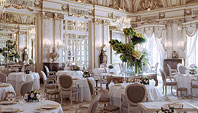
Le Louis XV.Photo: Courtesy of B. Touillon

1987
LE LOUIS XV
Monte Carlo

1995
LA BASTIDE DE MOUSTIERS
Moustiers-Sainte-Marie

1999
BAR BOEUF & CO.
Monte Carlo

1999
L’HOSTELLERIE DE L’ABBAYE DE LA CELLE
La Celle en Provence

2000
ALAIN DUCASSE AU PLAZA ATHÉNÉE
Paris
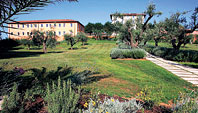
La Trattoria Toscana.Photo: Courtesy of Marie Hennechart

2004
LA TRATTORIA TOSCANA
Castiglione Della Pescaia

2004
MIX IN LAS VEGAS
Las Vegas
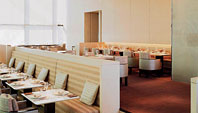
Beige–Alain Ducasse.Photo: Courtesy of Nagi

2004
BEIGE—ALAIN DUCASSE
Tokyo

2005
BENOIT
Paris

2005
BENOIT
Tokyo

2005
LE RELAIS DU PARC
Paris
L’Obsession